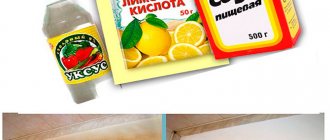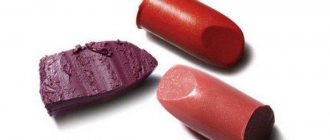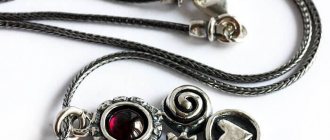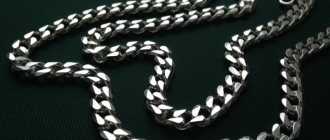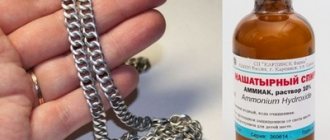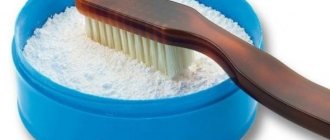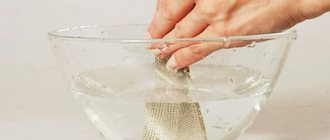Why can silver turn black?
In fact, there are many reasons why a chain or silver cross on a necklace darkens. The most common ones are:
- natural oxidation processes due to exposure to active chemicals contained in the environment;
- increased air humidity;
- contact with sea water;
- long-term storage of jewelry without wear (a year or more);
- reaction to body sweating;
- contact with household chemicals (for example, when washing dishes or laundry);
- contact of cosmetics, deodorant or perfume on the silver surface.
In order to lighten old jewelry and wash it of plaque that has formed over time, you can use several common methods. However, you always need to start with the main thing: removing fat that appears due to contact with the skin:
- you need to rinse the product under warm water;
- dilute a little liquid soap or mild shampoo in a container;
- using a brush with soft bristles, carefully brush the entire surface of the jewelry, paying special attention to the recesses and fasteners;
- Now you can rinse the product in water and dry thoroughly.
It must be remembered that after cleaning the jewelry should not be worn for 2-3 weeks. This time is enough for the formation of a protective layer on the surface of the product, which helps preserve the silver and protect it from darkening in the future.
Cleansing heavy stains
If the jewelry is very dark or has a greasy coating, it should be washed several times. Before using peroxide, the item must be soaked in a soapy solution and rinsed in hard-to-reach areas.
You can use a soft toothbrush and use it to clean out any stubborn stains. To clean, use soap, dishwashing detergent or regular toothpaste.
If the silver does not brighten at all, you can boil it for 2-3 minutes in a solution of ammonia, peroxide and soap.
Professional silver cleaning products
These compounds can be purchased at a jewelry store or workshop. You should select the product according to the type of decoration you want to tidy up. You can quickly and effectively clean silver using the following means:
- Apply the compositions in the form of foam to the product, and after 2-3 minutes remove with a soft cloth. They should not be used to clean jewelry that contains organic stones, enamel, or blackening.
- Pour liquid products into a vessel and lower the chain there for 5-7 minutes, then remove and polish with a cloth. Like foams, these products can harm enamel, blackening and stones of organic origin.
- The Aladdin solution will do an excellent job of removing darkening of silver if you dip a chain or ring into it for 15 seconds. Then clean the product with a napkin. This product should not be used on stones or enamel.
- The “Talisman” set, consisting of paste and napkins, will clean even very old products. To clean silver from blackness with this product at home, you need to apply the composition to the jewelry and then polish it.
After you have cleaned your chain or ring with any of these products, they should be rinsed under running water and dried. And to protect the skin of your hands while working, you should wear gloves.
Ready-made silver reading products
In addition, silver products can be taken to a jewelry workshop, where a master will clean the jewelry using professional means and methods.
How to clean silver if you can’t afford store-bought products? Use traditional methods.
Caring for jewelry with stones
After cleaning, silver with stones should be polished with a soft cloth.
Chains, pendants, rings with stones should be treated with professional products purchased in the store. Traditional methods are not suitable for washing such jewelry. Using industrial solutions, you don’t have to worry about the stone becoming dull or losing its shine.
If it is not possible to purchase the product, ammonia will do. Add 5-6 drops of alcohol to 200 ml of water. Dip the decoration into the solution, leave for 3-5 minutes, rinse with clean water.
After washing, the jewelry must be polished with a piece of flannel or suede.
How to clean a silver chain with baking soda
If you carefully care for your jewelry and do not allow heavy deposits to form, you can use the gentle dry cleaning method. To do this, you will need a paper towel or napkin and baking soda, which perfectly cleans many types of household stains.
When you have prepared everything you need, you can get to work. To manually clean your silver, do the following:
- Spread a paper towel on a flat surface.
- Pour baking soda onto the paper, spreading it evenly over the napkin.
- Place the decoration on top of the powder and wrap it in a napkin.
- Gently rub the chain wrapped in a paper towel using the same motions as when hand washing. Pay special attention to the part of the decoration where the darkened areas are located.
- Hold the softened tissue between your fingers and gently clean the blackened chain by pulling it through the paper and wiping.
When finished, remove the soda using a piece of soft cloth. If particles of the substance remain after this, it is permissible to rinse the jewelry in warm water.
Useful tips
Take help from professionals. This way you will have a guarantee that not a single millimeter of your favorite pendant or ring will be damaged.
This is especially true for items with engravings, with inserts of enamel, pearls, and precious stones.
Use a special cloth, this is sold in every jewelry store. Moreover, each precious metal has its own. Be careful, read the labels! A gold napkin will not work for you!
Before starting the process, wash the metal in soapy water. You can even use household cleaning products.
After this, use a soft brush to scrub the darkened areas, and for hard-to-reach places, use a cotton swab. Ordinary medical alcohol will also help solve the problem.
You need to either soak it in it for a couple of hours, or wipe it with a rag (cotton wool) soaked in it.
If there are inserts with precious stones, cleaning is carried out only with alcohol or soap.
There are many ways to help clean your favorite brooch and earrings. Let's look at the main ones.
How to clean silver using baking soda and foil
Cleaning with soda and foil is considered the best among those carried out at home. It does not require a lot of time, effort, and, importantly, finances.
But you should be aware of some limitations when working with soda, as well as other abrasive substances (for example, salt):
- Do not clean very smooth products so that minor damage does not remain on them;
- It is best to clean jewelry with small details, cutouts and designs;
- unlike precious stones and fionites, which should not be exposed to such influence, silver items with pearls tolerate the procedure well;
- You should not add vinegar to soda, which can cause a lot of damage to jewelry.
This option for processing jewelry allows you to quickly remove dullness and darkening. In addition, this method can be used to clean not only jewelry, but also dishes. You just need to make sure that there are no precious stones on the jewelry.
The essence of the method is that when a silver surface is treated with foil with the addition of soda, a small charge of electricity appears on the surface, which has a destructive effect on dirt and allows you to remove darkening.
There are four types of application of this method:
- Cover a deep container with foil, then place the silver in it and cover it with soda. Now you just need to add boiling water to this bath. After the reaction is over, remove the jewelry. Alkaline bubbles will completely remove all darkening.
- Another method involves boiling 0.5 liters of water and 2 tablespoons of soda in a solution. After five minutes, you can put the silver in there, laying it down with foil, and it should lie in this container for 5 minutes. Now clean the products using a soft cloth.
- The third option involves pouring soda and salt into a container with foil, adding a little liquid soap. The products should be filled with hot water and left for 5 minutes. With the help of soda, the plaque will dissolve, and the product will shine as before.
- You can clean old silver using soda like this: put foil in a pan; place silver items on it; Dissolve baking soda and salt in boiling water and pour into a saucepan; the interaction of foil with baking soda will soften the darkening, after which it will easily come off.
You can carry out such cleaning without worrying about your jewelry as needed.
Advantages and disadvantages
Due to the fact that peroxide does an excellent job of cleaning silver items from plaque and dirt, even jewelers use this product. After washing, the light shade, shine and brightness return.
Pros:
- high efficiency;
- ease of use;
- safety at work;
- low cost of the product.
- requires accuracy;
- can ruin an item with a low standard;
- with frequent use of the product, the silver will darken even more;
- If jewelry or cutlery is damaged, the quality of the metal cannot be restored.
How to clean silver with hydrogen peroxide
If you are going to use hydrogen peroxide (peroxide) to clean silver, then you need to know for sure that there are no impurities of any other substances in it and that this is really silver, and not cupronickel or simple metal.
Since if they are present, a chemical reaction is possible and as a result, streaks and stains will appear on your jewelry, which will be quite difficult to remove. Most likely, you will have to contact specialists.
Before you start cleaning your silver, be sure to test it in an inconspicuous place. Soak a cotton swab in peroxide and gently apply to the product. If the surface is not damaged, then the entire product can be processed. Hydrogen peroxide will whiten the jewelry and give the silver a natural shine.
- Cleaning silver with hydrogen peroxide is done as follows: soak the desired items in 3% peroxide and wait a while until the dark coating comes off. Then rinse the metal in clean water and wipe dry.
- Take 100 ml of hydrogen peroxide 3% and 100 ml of ethyl alcohol. Mix and place the contaminated decoration or cutlery into the resulting solution. If it is a chain or bracelet, you need to keep it in the liquid for 20 minutes. If you are cleaning rings, massive earrings, cutlery, you will need to wait for about an hour. But do not leave the products unattended, watch the process so that you can react in time if something goes wrong. When the exposure time has expired, thoroughly wipe the metal with a flannel cloth.
- It is necessary to take equal parts of ammonia, peroxide and liquid baby soap. Add all this to a glass of clean water and stir thoroughly. Immerse your silver items in the resulting liquid and leave for 15 minutes. After the time has passed, remove the jewelry, rinse well in warm water and wipe dry with a wool or flannel cloth.
Semi-professional cleaning with GOI paste
There are 4 varieties of a product called GOI paste. This is a universal method that allows you to clean the surface and polish it at the same time. All 4 types of paste are similar in composition; they are distinguished by the size of the abrasive particles. The choice is made taking into account the degree of contamination of the cutlery. The principle of using the paste is simple: apply the substance to a rag and rub the product until an excellent result is obtained.
It is possible to increase the sliding of the abrasive, and at the same time increase the efficiency of polishing, if you add a small amount of machine oil to the product.
Rules for cleaning silver using ammonia
Ammonia is considered one of the best means for removing plaque, dirt and discoloration. The reason is that ammonia is also an excellent solvent, which allows it to easily cope with complex silver stains.
During the cleaning process, the substance reacts with oxidizing agents (remember, they are the main cause of plaque formation), and as a result of exposure they are converted into ammonium salts. The metal cannot be harmed; ammonia is completely safe for it. In addition, this substance is highly volatile and quickly evaporates from the surface of silver.
The main thing is to follow a simple rule when working with ammonia, namely, do not soak jewelry in it for a long time. As a result of prolonged exposure to the chemical, the metal may change its color, for example, turn yellow.
Ammonia will do an excellent job of removing stains and deposits on silver without harming either the metal or your health if used correctly. How to clean silver with ammonia? Please note the principles of working with caustic compounds:
- during the cleaning process, protect your hands with gloves and your respiratory system with a medical mask, since ammonia has a caustic structure and a pungent odor;
- clean silver jewelry separately from items made of other metals, otherwise alloys of different densities and properties will undergo an unpredictable chemical reaction under the influence of ammonia (for example, silver may become yellow, and gold purified together with it may become white or pink);
- When cleaning, do not use rough, hard sponges; it is better to use a soft cloth, foam rubber, and in case of severe contamination, an old toothbrush;
- if the product has not darkened much, limit yourself to cleaning in a weak soap solution, and save ammonia for more serious stains;
- if there are stones on the jewelry, it is necessary to reduce the percentage of ammonia in the cleaning solution (no more than 5 drops per 200 ml of water), in addition, only durable and chemical-resistant stones, for example, diamonds, can be cleaned in this way;
- when stones are glued to metal, avoid cleaning methods that involve soaking the product in ammonia-based products, since this composition is a solvent and easily neutralizes the glue, as a result of which the stones will simply fall off;
- Do not use ammonia on items containing pearls or on gold-plated silver.
If you are not convinced that you can do everything correctly, or are not able to determine the origin of the stones on the product, it is better to seek professional help, excluding any experiments at home.
You can clean silver at home using ammonia according to one of these recipes:
- Aqueous solution of ammonia. Prepare a cleaning composition by mixing ammonia with water in a ratio of 1:10. Place decorations in this mixture; the time they remain in the solution depends on the degree of contamination. If the plaque is insignificant, 15 minutes will be enough, and if there is severe oxidation, the product can be kept in this liquid for up to 30 minutes. Then remove the silver from the ammonia solution, rinse under running water and wipe dry.
- Ammonia, chalk and soap. Make a weak soap solution and place the jewelry in it for 5-7 minutes. At this time, start preparing the cleaning paste, mix crushed chalk and ammonia so that you get a “gruel”. Remove the items from the soap solution, apply the paste to the silver, and when it hardens, rinse off the mixture and polish the item with a soft cloth.
- Ammonia and tooth powder (can be replaced with paste). The solution is prepared in the proportion of 2 parts ammonia to 5 parts water and 1 part powder or paste. The product must be mixed thoroughly, and then applied to the jewelry and cleaned off the remaining plaque and dirt. Afterwards, remove the composition under running water and wipe the silver with a soft cloth.
The last method of cleaning silver with ammonia is used for severe contamination, and it is also good for cutlery made of this metal. But it is strictly prohibited to treat products with stones with this composition.
If for some reason the listed methods do not suit you, and you do not want to contact a specialist, or do not have such an opportunity, you can use another cheap and safe recipe for cleaning tarnished silver with ammonia.
To carry out the work you will need:
- ammonia;
- hydrogen peroxide;
- filtered water.
To get your jewelry in proper shape, follow these instructions:
- Mix the ingredients in equal parts until a homogeneous mass is formed.
- Place the decorations in a container with the solution and leave until the plaque can be easily cleaned off or disappears on its own. However, remember that you can keep jewelry in ammonia for no more than 30 minutes.
- Remove the product and, if necessary, clean hard-to-reach areas or areas of particularly heavy dirt with a cotton swab.
- Rinse the silver in plenty of running water.
- Polish the surface using a soft cloth.
Do not forget that cleaning with “soaking” of products is best done only if the decoration does not have stones on the surface.
Precautions when working with ammonia
When working with ammonia, you must remember the caustic nature of the composition and take appropriate precautions:
- protect your face and hands from aggressive composition using gloves and a mask;
- use tweezers to place objects in the solution and then remove them;
- do not lean over the vessel with the cleaning solution, this can cause burns to the mucous membranes and chemical poisoning;
- work with ammonia only in a well-ventilated area, with open windows;
- If the composition comes into contact with unprotected skin, immediately rinse the area with plenty of running water.
Reviews
My silverware is in the sideboard, in a closed box, with velvet inside. It's a nice set, but we've never used it. The color of the metal is still white, even though 10 years have passed since I was given this box.
Zhanna R. g, Stavropol
Liliya G., Moscow
According to my observations, silver loses color under the influence of aggressive substances (concentrated vinegar, other acids). I ruined 1 box of beautiful spoons and knives and forks. Since then I’ve been telling everyone so they don’t repeat my mistakes.
I have been cleaning silverware with chalk for several years now. It always helps, although sometimes there are divorces. I advise you to wash items after cleaning in plenty of water.
Maria P. g, Leningrad
How to prevent tarnishing of silver
To ensure that silver jewelry does not darken and remains attractive for a long time, the following rules must be followed:
- Store products separately from each other, in boxes, fabric bags or wrapped in soft flannel or wool rags.
- It is advisable to polish the jewelry every day using a piece of flannel.
- Remove jewelry before visiting beaches, swimming pools, saunas, as well as when applying creams and masks to the skin.
- When washing or cleaning, it is also better to put the accessories in the box, since fumes from washing powders, cleaning agents and detergents contribute to the appearance of plaque.
- If you have to take medications in courses, it is better to part with silver jewelry during this time. The fact is that some medications promote profuse sweating, as a result of which the metal quickly darkens upon direct contact with the skin.
- Once every 2 months it is necessary to clean silver using professional or folk remedies.
As is clear from the above, cleaning silver yourself is not difficult. But if the jewelry contains stones or enamel, it is better not to risk it and entrust this work to a specialist.
Silver occupies a special niche among other metals used to create jewelry. It has exquisite beauty and durability, allowing you to enjoy the products for many years and even pass them on from generation to generation.
Preparation
Before you start cleaning an item with hydrogen peroxide, you need to prepare it for washing. The first step is to remove the layer of dirt and grease that has accumulated in areas with relief. To do this, make a soap solution and leave the decoration in it for 3 hours.
Precautionary measures
When working with the product you should:
- put on rubber gloves;
- do not inhale the cleaning solution;
- Do not drip onto furniture or clothes, as stains will remain.
The product itself does not cause skin burns and does not harm the environment.
You need to work especially carefully when adding ammonia to the solution.
Can the product damage silver?
Peroxide can ruin a silver item. Before use, you should make sure that the item is made of a high-grade alloy. The higher the amount of impurities, the greater the likelihood that the metal will become even darker.
925 purity means that 92.5% is silver, and 7.5% is various impurities that ensure durability and quality. The lower the sample, the worse the item behaves when in contact with hydrogen peroxide.
Low-quality jewelry and silver-plated cutlery cannot be cleaned with peroxide. You can only rub them with a dry cloth or use jewelry napkins.




